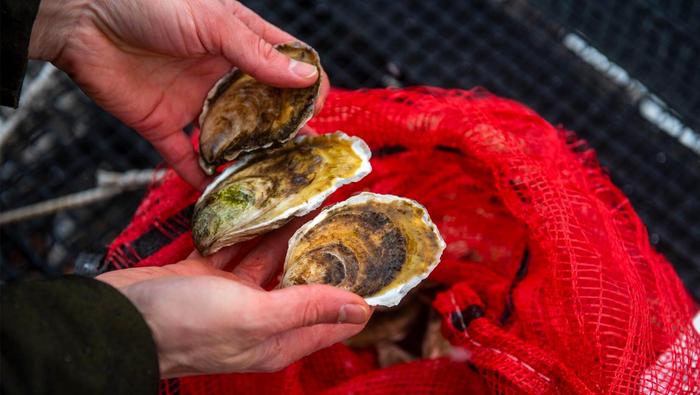From lobster to haddock and seaweed, seafood plays an important role in the U.S. economy, diet and culture. The nation is one of the top producers of marine and aquatic foods worldwide, but also the second largest seafood importer.

Credit: Photo courtesy of the University of Maine.
From lobster to haddock and seaweed, seafood plays an important role in the U.S. economy, diet and culture. The nation is one of the top producers of marine and aquatic foods worldwide, but also the second largest seafood importer.
Through extensive data analysis and calculations, University of Maine researchers found the U.S. could achieve seafood independence, or meet its entire seafood needs through its own production. But according to their new study in the academic journal Ocean Sustainability, published by Nature, “achieving greater seafood independence would require shifts in consumer behavior, investments in infrastructure and continual adaptation in the face of climate change.”
Becoming seafood independent offers opportunities for the U.S. to improve dietary outcomes as well as individual and national food security, particularly against disruptions in global supply chains, according to the research team. Despite its capacity to rely solely on the seafood it produces, the nation exports the majority of it and imports 80-90% of the seafood Americans consume.
“There is a tendency to forget that seafood is an integral part of the nation’s food system, but achieving greater seafood independence can improve equity, health and buffers from climate change,” said Joshua Stoll, UMaine associate professor of marine policy, who co-authored the study with postdoctoral research fellow Sahir Advani and Ph.D. student Tolulope Oyikeke.
Researchers conducted the study using 50 years of consumption and production data, from 1970-2021, for the nation and its seven regions as classified by the U.S Regional Fishery Management Council. Those regions are New England, the Gulf of Mexico, the mid-Atlantic, the south Atlantic, Alaska, the West Coast, Hawaii and other states. Based on that data, the team determined the extent to which the nation and its regions could meet their seafood demand through their own production, with 100% indicating the potential for complete seafood independence.
National seafood consumption, particularly of fish and other non-shellfish species, has increased over the past century alongside population growth and shifts in culinary preferences, but not enough to pass the overall uptick in production. Per capita consumption rose from 11.7 to 20.3 pounds, according to researchers. Producers, however, have reached a mean annual production volume of 7.5 billion pounds, which could yield 21.4 pounds of food per capita.
Despite the high production volume, the U.S. most recently could meet only 76% of its seafood demand with its own supply between 2012-21. That metric, akin to seafood self-reliance, and the ability to achieve independence fluctuated over the past 50 years from a low of 59% to a high of 110%, according to researchers. The disparity between actual seafood self-reliance and the ability to increase it comes from using much of what is harvested for global exports or as bait fish for more profitable species.
“As we strive to enhance our seafood self-reliance, we have the potential to reassess our consumption of harvested species. By focusing on species like herring, anchovy and other less widely consumed species over those that we export or use for bait, we can tap into their exceptional nutritional value, rich in omega-3 fatty acids and essential nutrients. This shift would not only strengthen our domestic seafood supply but also contribute to a more sustainable, affordable and health-conscious food system,” said Oyikeke
U.S. potential to achieve seafood independence is driven primarily by Alaska, home to two-thirds of the nation’s annual seafood harvest for the past three decades. With the ability to meet 27,000% of its regional seafood demand with a production that peaked at about 6 billion pounds in 2015, it proves to be the most self-sufficient region. The Mid-Atlantic region, however, is the least self-sufficient, only capable of meeting 7% of its seafood demand through the half-century.
New England was the third most self-sufficient region in the country from 1971-2021. Its capacity for self-reliance fluctuated over the years, peaking in 1979 with the ability to meet 179% of its seafood demand. Since then, however, its self-sufficiency plummeted to only being able to meet 36% of its demand through its own production in 2021 “due to historic overfishing, catch regulations, and the increasing total per capita consumption,” according to the study.
“It is hard to predict what will happen in the future, but ongoing efforts to restore fisheries in the Gulf of Maine and the nascent, but burgeoning aquaculture sector may help to increase the potential for self-reliance in the future,” said Oyikeke.
While the U.S. is capable of achieving seafood independence, researchers said its per capita consumption of 20.3 pounds falls short of the recommendations of the U.S. Department of Health, which is 26.07 pounds.
To increase self-reliance and better dietary outcomes, researchers said the industry must work toward incentivizing changes in consumer preferences, particularly incorporating fish that are typically only used as bait into their diets; as well as increasing shellfish production to meet current demand for these species by investing in small-scale community aquaculture.
They must also eliminate barriers to access experienced by historically marginalized populations and reshape infrastructure to better serve local and regional markets by investing in more cold storage, waterfront access and distribution networks. Additionally, researchers said any actions taken should factor in the possible impacts of climate change.
“As more attention is being given to the relationship between socioeconomic well-being, human health and food, now is the time to invest in increasing seafood self-reliance. Given current seafood production levels, doing this is not beyond reach,” said Stoll.
Journal
npj Ocean Sustainability
Article Title
Seafood independence is within reach: a multi-scale assessment of seafood self-reliance in the United States
Article Publication Date
7-Jul-2024



